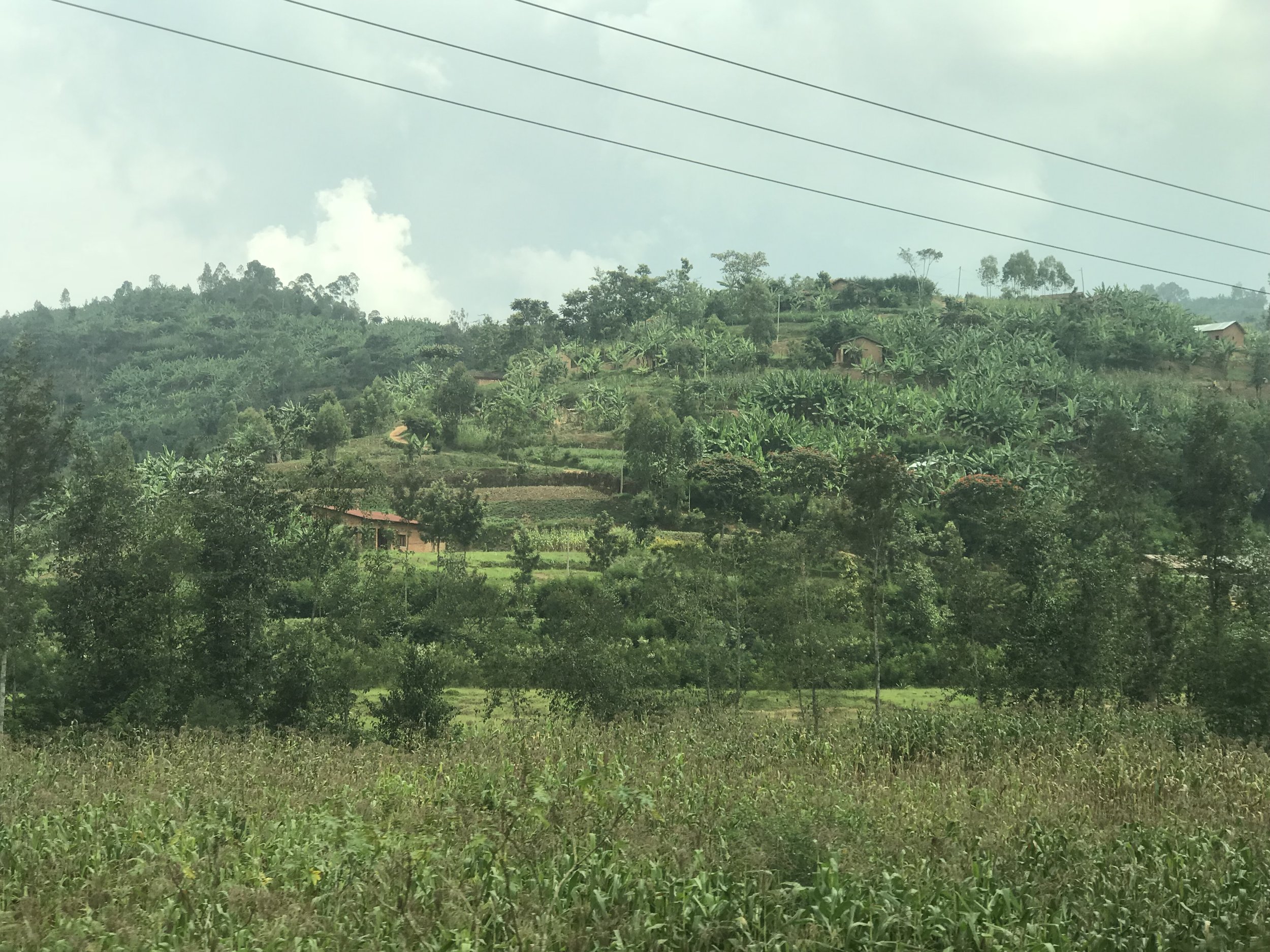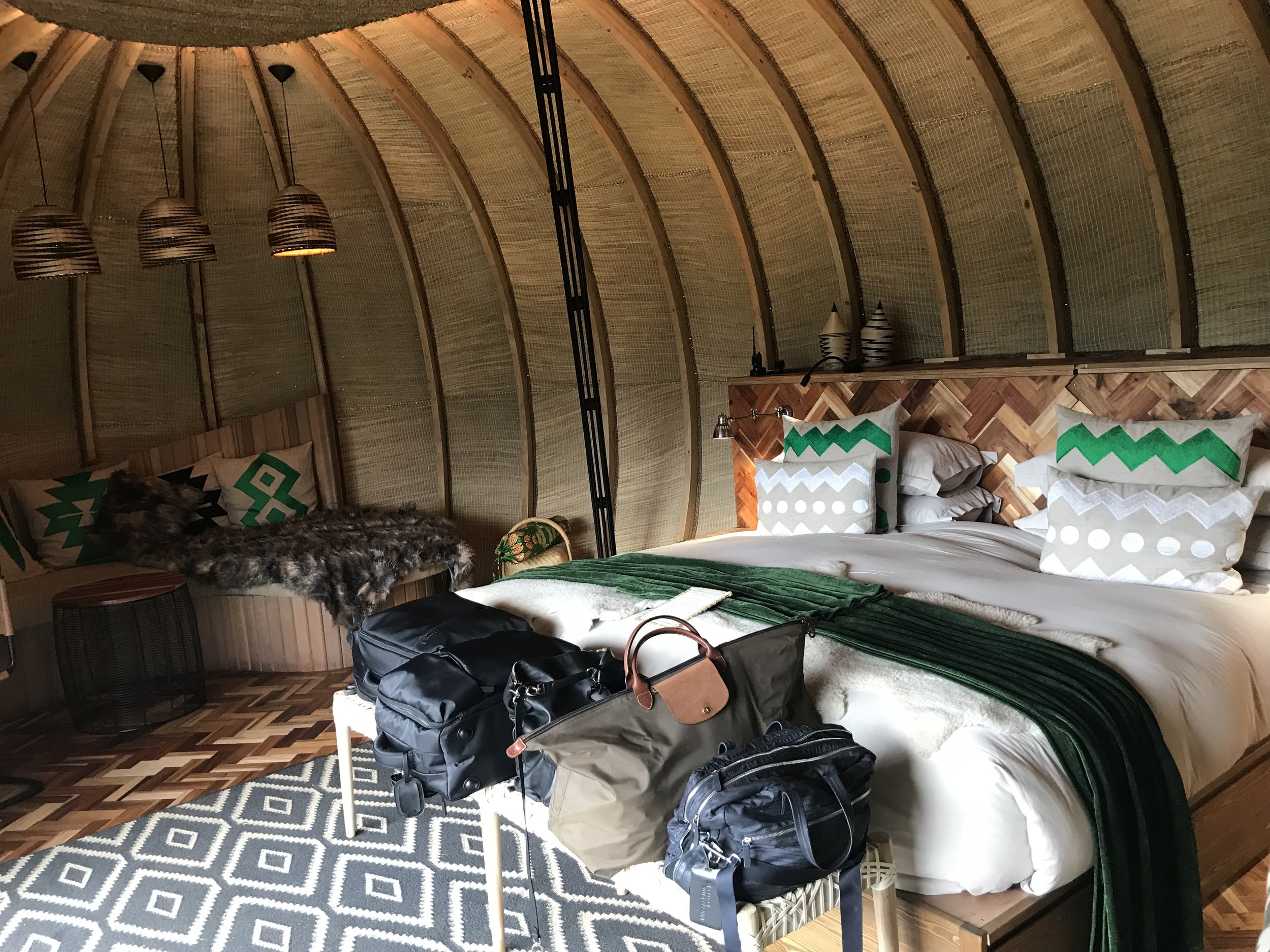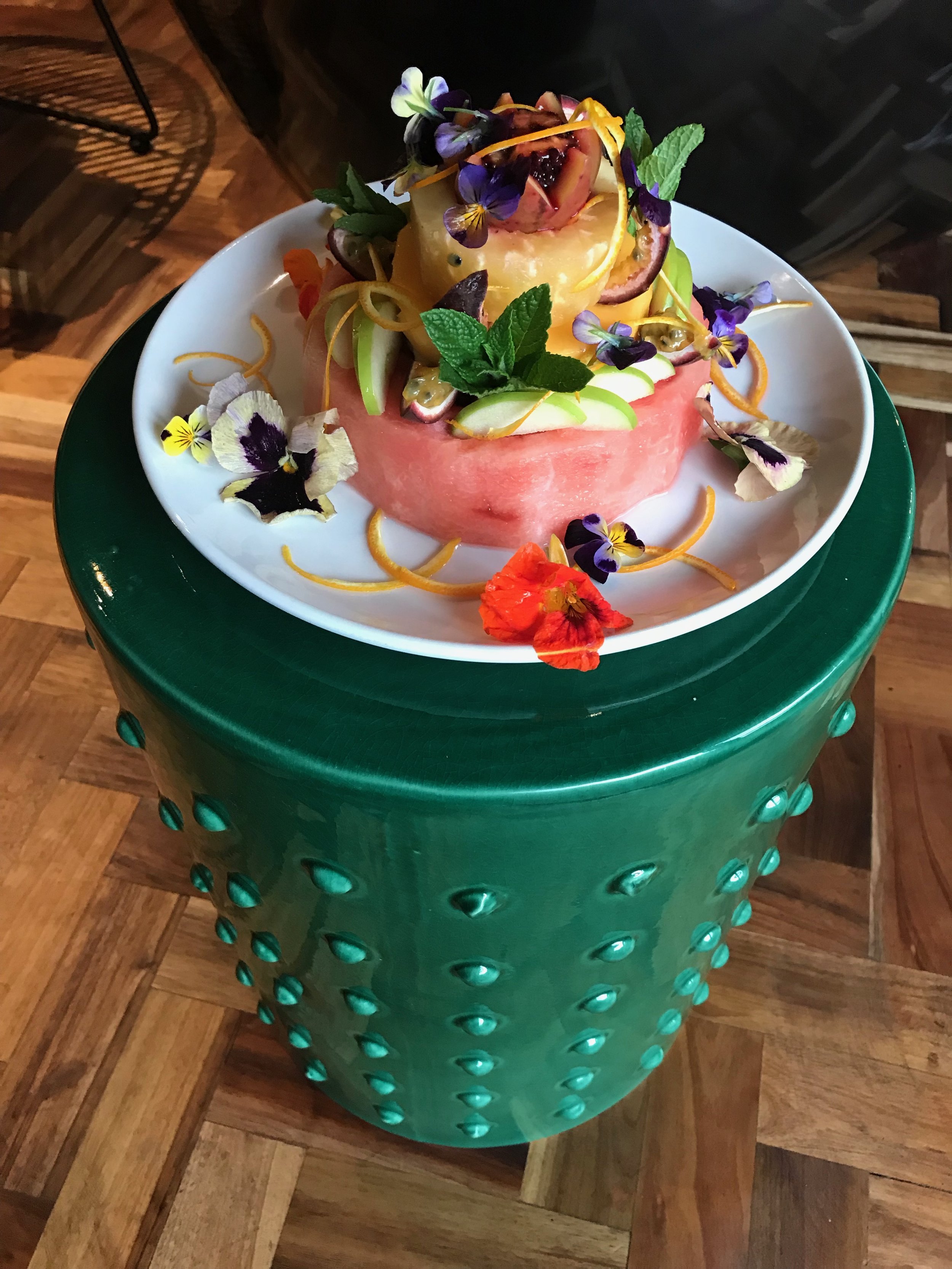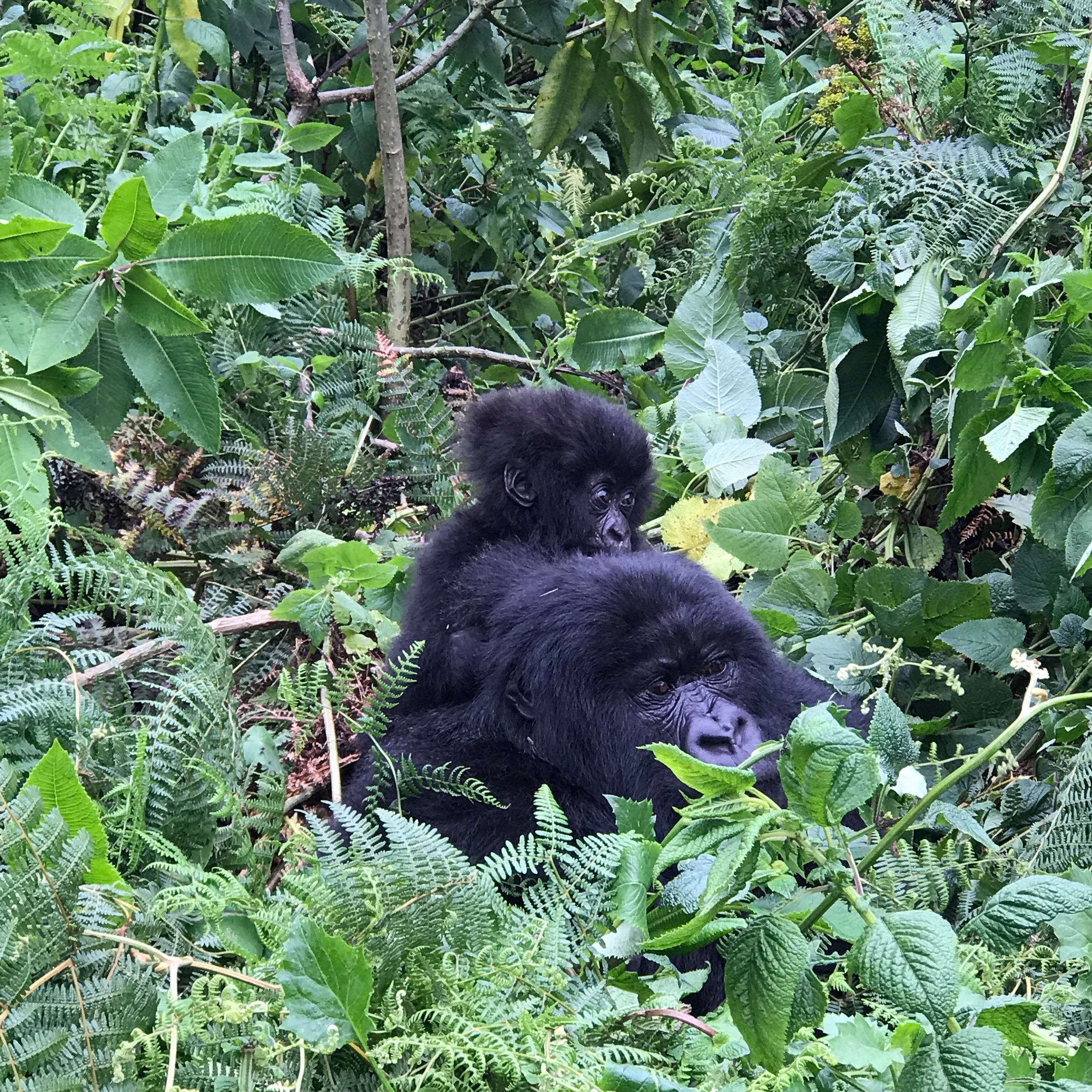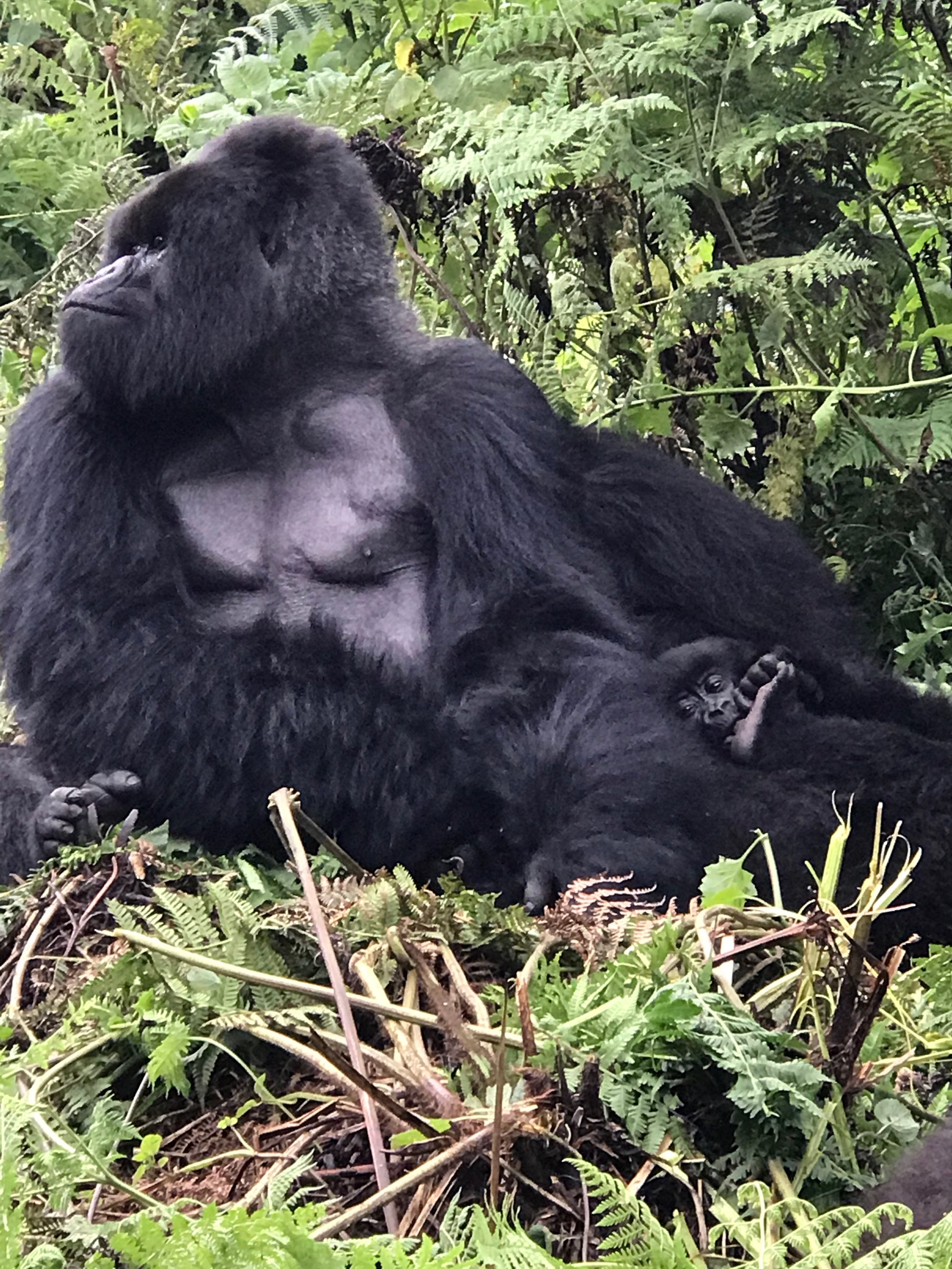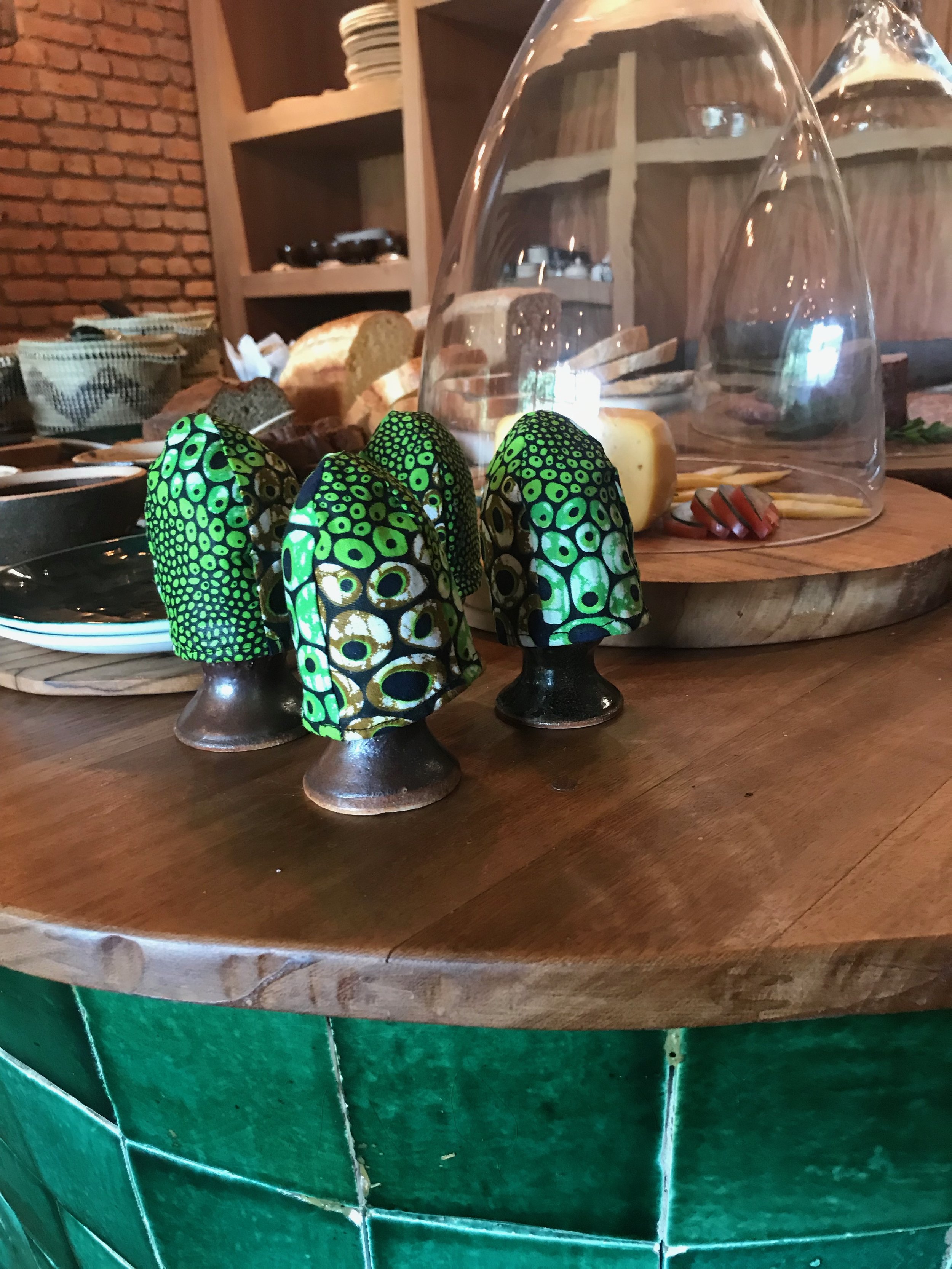An hour into the 3.5 hour drive to Volcanoes National Park, we were in the countryside, and the roads still looked like they were landscaped by professionals - small shrubs of acid green and dark purple backed by bamboo and trees. The farms beyond were organized and terraced to show off their abundance of banana palms, corn groves and rice paddies. Cows roamed and grazed without any fencing or restrictions.
I took hundreds of photos of the women walking along the road. They wore a dazzling mashup of African fabrics - mismatched patterns which looked so striking against the continuous blur of green foliage behind them. They carried pineapples, grasses, corn, potatoes and squash on their heads and had babies swaddled to their backs and chests. The men rode bicycles to transport even larger bundles of potatoes, bananas branches, and the ubiquitous yellow plastic containers of water balanced precariously across the seats and handlebars of their bikes.
Ghost
Twig in balance
Umbrella Family
Headdress of Three women. Okay I am stopping at 3/100!
Arriving at the Bisate Eco-Lodge was a breathtaking moment. The hotel was a stunner. Staggered down the side of a forested mountain were six two-eyed villas that appeared to float among the treetops. They looked to be hand woven from palm fronds and designed to resemble enormous Weavers nests.
Bisate Eco-Lodge
The staff greeted us with awelcome song at the bottom of the steps. This is what Joy looks like!
Apparently the first of our hikes would be to get to our ‘nest’ on this mountain. It was the most elegant, ethnic, modern and luxurious room I think I have ever stayed in. The bedroom had two lounge areas, a workspace, a fireplace that acted as a partition between the seating area and the bathroom. The entry had a small kitchenette with coffee, tea + daily cookie deliveries and a refrigerator. The balcony looked onto the distant Bisoke + Karisimbi Volcanoes, shrouded in an almost constant ‘mist.’ Housekeeping tended to the fire through the day, so when we returned from breakfast, dinner or a trek it was always toasty inside.
Traveling light!
Note to self : Next House has a bathroom with a fireplace!
A furniture forward view to the volcanoes.
The main hotel space was up several flights of stairs. It was another group of ‘nests’ that housed the cocktail and coffee bars, the restaurant, a small gift shop, and restrooms. There was also a private dining area and wine cellar downstairs.
Wine bottle Chandelier
After an early dinner in the hotels main building, we returned to our wood-burning suite to discover furry hot water bottles in our bed - that was a first, and maybe a nod to the black gorilla fur we would see tomorrow.
DAY 1 : 1/27/2018 : Avrams Birthday Trek
We had a 4:45am wakeup call, a 5:45am breakfast, then we were outfitted with our gators + gloves, and left the lodge at 6:30am for a 7am briefing. The gators+gloves were necessary protection against stinging nettles and ants.
Trek ready!
The orientation site was a hive of activity, a large pavilion that is the meeting grounds for all of the drivers, guides and tourists from all of the hotels in the area. Everyone grabs coffee, tea and the last bathroom opportunity for several hours. Oh yeah - in addition to everything the guides would tell us about the Gorillas, they also counseled us on how to properly create and cover-up any bathroom stops that one might need on their way up the mountain. I privately made a commitment not to eat or drink anything until AFTER our trek so I would not have to dig holes, squat, and then cover it up, possibly with an audience.
There are now over 1000 Gorillas that live in Uganda, the DRC (Democratic Republic of Congo) and Rwanda. They live above 10,000 feet on the slopes of volcanoes. In Rwanda there are 10 gorilla families with around 186 gorillas in all. It was the anti-poaching work of Dian Fossey that began in 1963 that greatly contributed to their preservation, and unfortunately to her mysterious murder in 1985. Today the protected gorillas have generated a booming tourism trade. Each person pays a daily fee of $1,500 USD to spend one hour with the gorillas. Part of the fee goes to conservation and part to the local communities. They issue about 80 permits a day for an income of approximately $120,000 per day - quite lucrative. Tipping for the guides, porters and trackers are not included. We were instructed by our amazing travel team at Dufflle &Compass to bring lots of USD - small bills and new bills. This was a bit of a struggle to obtain in Israel, multiple bank visits, IDs, and explanations were necessary. There are no refunds on the trekking fees, which is a risky situation especially if you are traveling from abroad. And, if there is even a hint that you may be ill (diarrhea and sore throats included) you cannot go on the trek. Human diseases can kill Gorillas. They have very few natural predators and are considered ‘critically endangered’ because of man made disasters - wars, human disease and habitat destruction.
At the pavilion we met our guides for Day 1, Placide and Emmanuel. There were eight people in our group including two women who had tried to visit the gorillas the day before. Because of their slow pace, they were unable to make it up the mountain. We benefitted from this because the drivers were instructed to take our group by car as far as they could into the forest. I was very happy to be in this group, because it meant it would be an easier trek than we were expecting. The drive into the forest was a muddy, bumpy, hilly, jiggly route. Charles told us the locals refer to this experience as an ‘African Massage.’
Before we began our ascent into the forest, Placide and Emmanuel taught us some very basic Gorilla etiquette and communication skills. First, always crouch low if a gorilla approaches you - a sign of being submissive. You can never touch a gorilla, but they can touch you and sometimes will to show off their power. The young males will literally beat their chests to show their strength. So King Kong! And actually funny to see these teenagers doing this - because its more funny than terrifying. We are allowed to take pictures, its encouraged, with an exception - no flash photography. Despite what I had thought, it’s fine to look the Gorillas in the eyes. We were taught how to say good morning, which basically sounds like an old man clearing his throat - a gutteral Hmm, Hmmmmm. And to recognize the Gorilla sound of alarm or stress which is a clicking sound they make using their tongues. Much like the uniqueness of human finger prints, each gorilla has unique wrinkles around their noses called a nose ‘print’ the is used for identification purposes.
We share 98% of of our DNA with the Gorillas. Here is his Nose Print.
Our group was led by trackers with guns and walkie talkies. We were told the guns are not for the Gorillas, but for the Wild Buffalo and Elephants that also live in the forest. This definitely added a dangerous undertone to the hike. I was worried about the Gorillas - the gentle giants - and now we have to worry about being trampled by Wild Elephants and Buffalo? (Umhate! Umhate! Courage! Courage!)
Bamboo Forest with Stylish Guides and Trackers
They took us to visit the Sabyinyo group. Sabyinyo means ‘old mans teeth’ and is named after the jagged mountain peaks. The Sabinyo group has 2 Silverbacks and 17 gorillas, including the oldest Silverback in Rwanda. The average life expectancy of a Silverback is between 40-50 years. Our trackers were in touch with other trackers deeper in the forest that knew where the Sabyinyo group slept the night before and have since followed them to their current location to help us find them easier. Once found, we get 1 hour with the group to watch their behavior and take photos. The beginning of the trek was in deep mud which caused us to slide around. We were balanced by personal porters along the way and somehow these tall skinny Rwandans kept us relatively steady, and carried our backpacks for us.
The bamboo was sparse at the base of the mountain and became more dense as we climbed. There were also Eucalyptus trees, thistle, wild celery and bushes of stinging nettle all around. A perfect environment for our herbivore ancestors. A dangerous environment for us if we were to land in a stinging nettle bush. Ahead of us the trackers used machetes to clear the way over the hills and through the forest to where the Gorillas were lazing around after their breakfast.
This was the best time to see them, as they were happy, fed and frolicking with their family. We saw Guhonda, the oldest Silverback in the park at 44 years old. He was huge (485 lbs, almost 6’ tall) and a very sedentary and solitary leader who sat far from his troop. He barely moved, and after watching him for a while,he managed three activities. I saw him pick his nose and eat it, yawn, and then he rolled over and landed a little way down the mountain to where the rest of his family was playing in the bush.
As our anxiety lessened (at least on safari you are in a jeep!), and we became more comfortable in their presence, we walked around and saw 12 of the 17 members of the family in various scenarios. It struck me how close we actually were, and how used to humans the gorillas seemed to be. A mom breastfed her baby a few feet from us, another mom rolled around with two youngsters, various teens (blackbacks) snacked on bamboo, and as our hour came to a close and we walked out of the park, and could see a few other gorillas hidden up in the the treetops. It was an incredible experience to be in such close proximity to observe these wondrous, wild creatures.
We made it back to the hotel just three hours after we had left and had the day to ourselves. On offer were tours to a local village, a trek to see the golden monkeys and a walk around the trail on the property. It just seemed that nothing would come close to what we had just been through. We decided to hang at the hotel and enjoy a fireside bath. We also took advantage of the hotels many thoughtful services like daily laundry and boot cleaning. By the next morning our hiking boots looked brand new sitting on the doorstep.
In the room was a birthday ‘cake’ for my Silverback, from our friends in Tel Aviv. Instructed by Eden&Dean&Co the kitchen produced a carb-free ‘cake.’ It was made entirely of fruits and flowers and was the most creative, innovative and beautiful ‘cake’ we had ever seen.
Not your Grandmothers Fruitcake!
In the afternoon we watched from our balcony the arrival of guests using the Helipad at Bisate. The alternative to driving 3.5 hours from Kigali, is to take a short helicopter ride that lands directly in front of the hotel. The local kids all run to the base of the hotel to cheer and to watch it land. In a place where feet, bicycles and cars are the norm, a helicopter is a by far a more exciting arrival. At dinner, we overheard the helicopter group complain about the weather delays and how they almost didn’t make it to the hotel for their trek the next morning.
DAY 2 : 1/28/2018
Today we had a repeat of the wakeup call, breakfast, fitting of the gators+gloves and drive to the meeting point to be put into groups. We were assigned to visit the Hirwa group of 19 Gorillas with our new guides Edward and Mr. D. There was no repeat of the ‘African Massage’ instead it was a long walk to the forest edge through local farms of potatoes, corn and ‘desert flower’ which we were told is the basic ingredient in used to make organic insecticide. I asked Edward if this was an organic farm. He said No, while all of the ‘desert flower’ is harvested here, it is much more valuable as a product to be shipped to the west. Rwandans use the normal non-organic insecticides. I found this alarming as I passed a sea of beehives in a neighboring farm.
Rwandan Beehives
This hike was longer and more strenuous, straight up hill, and then down a freshly machete cut path that was really a narrow, steep and muddy ditch dug by the guides so we could land at the feet of the Hiwa family. The Hirwa group ‘the lucky ones’ was a merger of some stray Sabyinyo and Agasha ‘the news’ gorillas. They reinforced their luckiness in 2011 by having twins, which is rare in the Gorilla world. Usually the females will give birth once every four years, as they wean their young for up to 3.5 years - one reason why the species grows so slowly.
It seems that we were ‘the lucky ones’ to find them all together being a Gorilla family on the mountain top in a very bushy clearing. The Silverback - called this for the graying hair on its back, was doing his patriarchal duty lounging in the grass after breakfast as his wives, teenagers and kids tumbled on top of each other play fighting, beating their chests and swinging from tree vines. Our group of 8 tourists was outnumbered 2 to 1. But even though the Gorillas kept an eye on us, we were able to get surprisingly close, taking pictures and observing them uninterrupted for a complete hour - which went by very fast.
Hand over Foot
Proximity and Scale
The sheer size of the grown ups is sobering
There were a few scenes that stood out. A mother with a very tiny baby on her back. He was able to sit up straight, but he looked totally stoned and dazed watching our group and his new family. The mother didn’t seem worried or defensive at all to be surrounded by humans madly clicking their cameras. One small Gorilla was my favorite. He came flying off of a vine near me and charged forth with energy and determination. From behind he looked like a stuffed Curious George, so much so that I wanted to grab him. Luckily I had my video on and caught his trek from the forest to navigating the ups and downs of the foliage on his knuckles. A large branch barrier got in his way and I could actually see him thinking about how to get around it. His mom saw him coming towards her and leaned in for a kiss only to be pushed away as he made a beeline for his dad. He continued on to jump and play with his siblings. I thought it was the coup of all coups to get that on video.
At the one hour mark, as if on cue, the the Silverback did his other ‘job’ which was to signal to the group that is was time to move on, he would lead the family to their next foraging opportunity and then find a place to spend the night. He stood up and ambled off stage left with the entire 18 family members following in his footsteps. The guides said ‘ Okay everyone the show is over!’ which was very funny because it made the entire episode seemed choreographed in some way. So the trek back up and over the narrow and muddy ditch began. A was at the front of the group and I was at the back with our guide Edward. All of a sudden Edward said ‘everyone move off the path and into the bushes and crouch down’ it was so sudden, that you just did as you were told. And then the most incredible thing happened. The silverback and all of his family paraded in front of us, one by one, using our path to exit the area. The Silverback was at least 500 lbs, and larger that the width of the ditch. We were crouched low to their level and I watched as his knuckles went down within a 1/2 inch of my foot. I could see his gentleness in the way he placed his fist lightly into the dirt, he almost seemed to be aware of avoiding my shoe. The mom with the tiny baby clutching her back was behind him, and the rest followed. We were so close we could see forest dust on their fur, hear the smack of leaves they were chewing, and you could smell them as they walked by - each with a tube of uni-colored post breakfast shit coming out of their butts as they passed us. Forgive the lack of visuals here! It turns out that the fecal matter is very important for the researchers. It allows them to monitor the Gorilla DNA and enables them to estimate the population. As a parting gift, I think each of us took some traces of DNA back with us stuck in the treads of our hiking boots. This finale was was positively exhilarating.
On the way back to the hotel, we took a scenic drive. We saw a giant Gorilla sculpture made of bamboo that is used for ‘Naming Ceremonies’ for newly born baby gorillas. The government invites dignitaries and uses these ceremonies to create awareness for the protection of the Mountain Gorillas.
Afterward Charles took the opportunity to explain the local educational and property value systems to us. Education is compulsory from Primary school to High School. After that University attendance is according to wealth. The scale to judge this wealth was based on buying power. If you can’t afford sugar - University is free. If you can’t afford Shoes, its half-price. If you are the son or daughter of a minister or an entrepreneur, then University is full price. As we drove one could see that the countryside was filled with crops, grasses and many many trees. Apparently the government determines land value based on the number of trees on any given property. The trees are worth $10 each, so people keep as many trees as possible on their land.
Today our in room gift was bamboo fiber ‘ecoffee cups’ with the Bistate logo. The hotel prides itself on being eco-friendly and sustainable. They have several projects underway that support the local communities. 50% of their staff are locals, and they employed 200 people while under construction. The lodge is constantly planting the surrounding land and they use gray water and rainwater harvesting from mountain springs. They are even building a large ‘water fountain’ so that the locals can walk a short distance from their homes to collect water for their daily needs, maybe eliminating the need for those giant yellow plastic containers.
After lunch we decided to walk the nature trail around the Bisate property, to see the re-foresting efforts first hand. Not sure what we we were expecting, but this hike was almost more strenuous than the Gorilla treks. It turns out the hotel was built on the side of another volcano and we were actually walking around the top of the crater. From the ridge we could look down into the neighboring villages and hear singing from the valley below.
DAY 3 : 1/29
After breakfast we returned to our room to pack and found two small trees in our suite. The hotel gifts each guest with a tree (ours were Hagenia or African Redwood) that we/they can plant on the property, as a way to for the guests to participate in the Bisate re-foresting effort. And we added $20 to their property value! We received a certificate with GPS coordinates, so if we ever return we can visit our trees.
Breakfast at Bisate
Egg Cosy
Charles collected us up for the drive back to Kigali. We booked a room back at The Retreat at Heaven for the day, so we could have a nice lunch, use the wifi and relax before our evening flight to Kenya. We left the Gorillas to their next lucky visitors, as we looked forward to visiting the Elephants and Giraffes of Nairobi.
